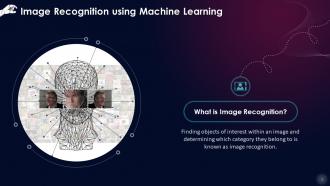Image Recognition Using Machine Learning Training Ppt
This set of slides provides information about Image recognition using Machine Learning. It discusses how it works and tells us about its models Support Vector Machines, Bag of Feature Models, Viola-Jones algorithm.
You must be logged in to download this presentation.
PowerPoint presentation slides
Presenting Image Recognition using Machine Learning. These slides are 100 percent made in PowerPoint and are compatible with all screen types and monitors. They also support Google Slides. Premium Customer Support available. Suitable for use by managers, employees, and organizations. These slides are easily customizable. You can edit the color, text, icon, and font size to suit your requirements.
People who downloaded this PowerPoint presentation also viewed the following :
Content of this Powerpoint Presentation
Slide 1
This slide introduces Image Recognition. Finding objects of interest within an image and determining which category they belong to is known as image recognition.
Instructor’s Notes: Image recognition is a computer vision application that entails tasks such as object detection, image identification, and image categorization.
Slide 2
This slide discusses the working of Image recognition using Machine Learning. Machine Learning techniques are used to glean out hidden knowledge from a dataset of good and bad samples to recognize images.
Instructor’s Notes: When combined with robust AI technology and GPUs, Deep Learning allows for significant advancements in the field of image recognition. Image classification and facial recognition algorithms using Deep Learning reach human-level performance in real-time object detection.
Slide 3
This slide illustrates Machine Learning Image Recognition Models such as Support Vector Machines, Bag of Features Models, and Viola Jones Algorithm.
Instructor’s Notes:
- Support Vector Machines: SVMs function by creating histograms of images that may or may not contain the target items. Next, the program compares the trained histogram values to those of portions of the test picture to see if there are any matches
- Bags of Features Models: Bag of Features models like Scale Invariant Feature Transformation (SIFT) and Maximally Stable Extremal Regions (MSER) function by scanning an image and comparing it to a reference photo of the object to be discovered. The model then pixel matches the features from the sample photo to regions of the target image to see if there are any matches
- Viola Jones Algorithm: Viola-Jones scans people's faces and extracts features, which are then fed into a boosting classifier. As a result, boosted classifiers are created and used to check test photos. A test image must yield a positive outcome from each classifier to find a successful match
Slide 4
This slide depicts the Image Recognition Application for Face Analysis. The video feed of any digital camera or webcam can be used with modern Machine Learning technologies to do simultaneous face detection, face posture estimation, face alignment, gender recognition, smile detection, age estimation,and face recognition.
Instructor’s Notes: Computer vision allows computers to determine identity, intentions, emotional and health status, age, and ethnicity via facial analysis. Some photo recognition software even attempts to use a score to define levels of perceived attractiveness.
Slide 5
This slide discusses the Image identification systems powered by Machine Learning that are used in the agriculture sector. These systems employ cutting-edge tools that have been trained to recognize the type of animal and its behavior.
Image Recognition Using Machine Learning Training Ppt with all 21 slides:
Use our Image Recognition Using Machine Learning Training Ppt to effectively help you save your valuable time. They are readymade to fit into any presentation structure.
-
The team is highly dedicated and professional. They deliver their work on time and with perfection.
-
“Love it! I was able to grab an exciting proposal because of SlideTeam.”

















































